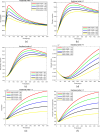The role of a vaccine booster for a fractional order model of the dynamic of COVID-19: a case study in Thailand
- PMID: 39774616
- PMCID: PMC11707013
- DOI: 10.1038/s41598-024-80390-6
The role of a vaccine booster for a fractional order model of the dynamic of COVID-19: a case study in Thailand
Abstract
This article addresses the critical need for understanding the dynamics of COVID-19 transmission and the role of booster vaccinations in managing the pandemic. Despite widespread vaccination efforts, the emergence of new variants and the waning of immunity over time necessitate more effective strategies. A fractional-order mathematical model using Caputo-Fabrizio derivatives was developed to analyze the impact of booster doses, symptomatic and asymptomatic infections, and quarantine measures. The model incorporates real epidemic data from Thailand and includes a sensitivity analysis of parameters influencing disease spread. Numerical results indicate that booster vaccinations significantly reduce transmission rates, and the model's predictions align well with the observed data. The basic reproduction number was determined to evaluate disease control, showing that a sustained vaccination campaign, including booster doses, is essential to maintaining immunity and controlling future outbreaks. The findings underscore the importance of ongoing vaccination efforts and provide a robust framework for policymakers to design effective strategies for pandemic control.
Keywords: COVID-19; Caputo-Fabrizio derivatives; Existence and uniqueness; Global stability; Model fitting; Vaccination.
© 2024. The Author(s).
Conflict of interest statement
Competing interests: The authors declare no competing interests.
Figures









Similar articles
-
Potential for eliminating COVID-19 in Thailand through third-dose vaccination: A modeling approach.Math Biosci Eng. 2024 Aug 9;21(8):6807-6828. doi: 10.3934/mbe.2024298. Math Biosci Eng. 2024. PMID: 39483094
-
Modelling on COVID-19 control with double and booster-dose vaccination.Gene. 2024 Nov 30;928:148795. doi: 10.1016/j.gene.2024.148795. Epub 2024 Aug 6. Gene. 2024. PMID: 39097207
-
Modeling COVID-19 dynamics in the Basque Country: characterizing population immunity profile from 2020 to 2022.BMC Infect Dis. 2025 Jan 2;25(1):9. doi: 10.1186/s12879-024-10342-y. BMC Infect Dis. 2025. PMID: 39748283 Free PMC article.
-
A quick scoping review of the first year of vaccination against the COVID-19 pandemic: Do we need more shots or time?Medicine (Baltimore). 2022 Sep 16;101(37):e30609. doi: 10.1097/MD.0000000000030609. Medicine (Baltimore). 2022. PMID: 36123868 Free PMC article.
-
Are COVID-19 Vaccine Boosters Needed? The Science behind Boosters.J Virol. 2022 Feb 9;96(3):e0197321. doi: 10.1128/JVI.01973-21. Epub 2021 Nov 24. J Virol. 2022. PMID: 34817198 Free PMC article. Review.
References
-
- Pushpendra, K. et al. Fractional dynamics of 2019-nCOV in Spain at different transmission rate with an idea of optimal control problem formulation. Alex. Eng. J.61, 2204–2219 (2022).
-
- World Health Organization. WHO coronavirus (COVID-19) Dashboard [Internet]. Available from: https://covid19.who.int/ (2023).
Publication types
MeSH terms
Substances
Grants and funding
LinkOut - more resources
Full Text Sources
Medical

